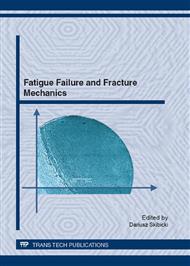[1]
J.P. Hirth, J. Lothe, Theory of Dislocations, 2nd Edition. Krieger Publishing Company, 1992.
Google Scholar
[2]
R.W. Hertzberg, R.P. Vinci, J.L. Hertzberg, Deformation and Fracture Mechanics of Engineering Materials, 5th Edition. Wiley, 2012.
Google Scholar
[3]
E. Cuthill, J. McKee, Reducing the bandwidth of sparse symmetric matrices, in: Proc. 24th ACM National Conference, Association for Computing Machinery, New York, 1969, 157–172.
DOI: 10.1145/800195.805928
Google Scholar
[4]
N. Moës, J. Dolbow, T. Belytschko, A finite element method for crack growth without remeshing. Int. J. Numer. Methods Eng. 46 (1999) 131-150.
DOI: 10.1002/(sici)1097-0207(19990910)46:1<131::aid-nme726>3.0.co;2-j
Google Scholar
[5]
J.A. George, J.W-H. Liu, Computer Solution of Large Sparse Positive Definite Systems, Prentice-Hall, Englewood Cliffs NJ 1981.
DOI: 10.1002/bimj.4710260217
Google Scholar
[6]
C.F. Gauss, Brief an Gerling vom 26 Dec. 1823, Werke, vol. 9, 278–281, in: Mathematical Tables and Other Aids to Computation (a translation by G.E. Forsythe), vol. 5, 1950, 255–258.
Google Scholar
[7]
M.R. Hestenes, E. Stiefel, Methods of conjugate gradients for solving linear systems, Journal of Research of the National Bureau of Standards 49 (1952) 409-436.
DOI: 10.6028/jres.049.044
Google Scholar
[8]
W.H. Press, S.A. Teukolsky, W.T. Vetterling, B.P. Flannery, Section 2.7.6 Conjugate gradient method for a sparse system, in: Numerical Recipes: The Art of Scientific Computing (3rd ed.), Cambridge University Press, New York 2007, 87-92.
DOI: 10.1086/416228
Google Scholar
[9]
Y. Saad, Iterative methods for sparse linear systems (2nd ed.), Society for Industrial and Applied Mathematics, Philadelphia, PA 2003, 181–182.
Google Scholar
[10]
T. Sogabe, M. Sugihara, S.L. Zhang, An extension of the conjugate residual method to nonsymmetric linear systems, Journal of Computational and Applied Mathematics 226 (2009) 103-113.
DOI: 10.1016/j.cam.2008.05.018
Google Scholar
[11]
S. Stören, J.R. Rice, Localized necking in thin sheets, Journal of the Mechanics and Physics of Solids 23 (1975) 421-441.
DOI: 10.1016/0022-5096(75)90004-6
Google Scholar


